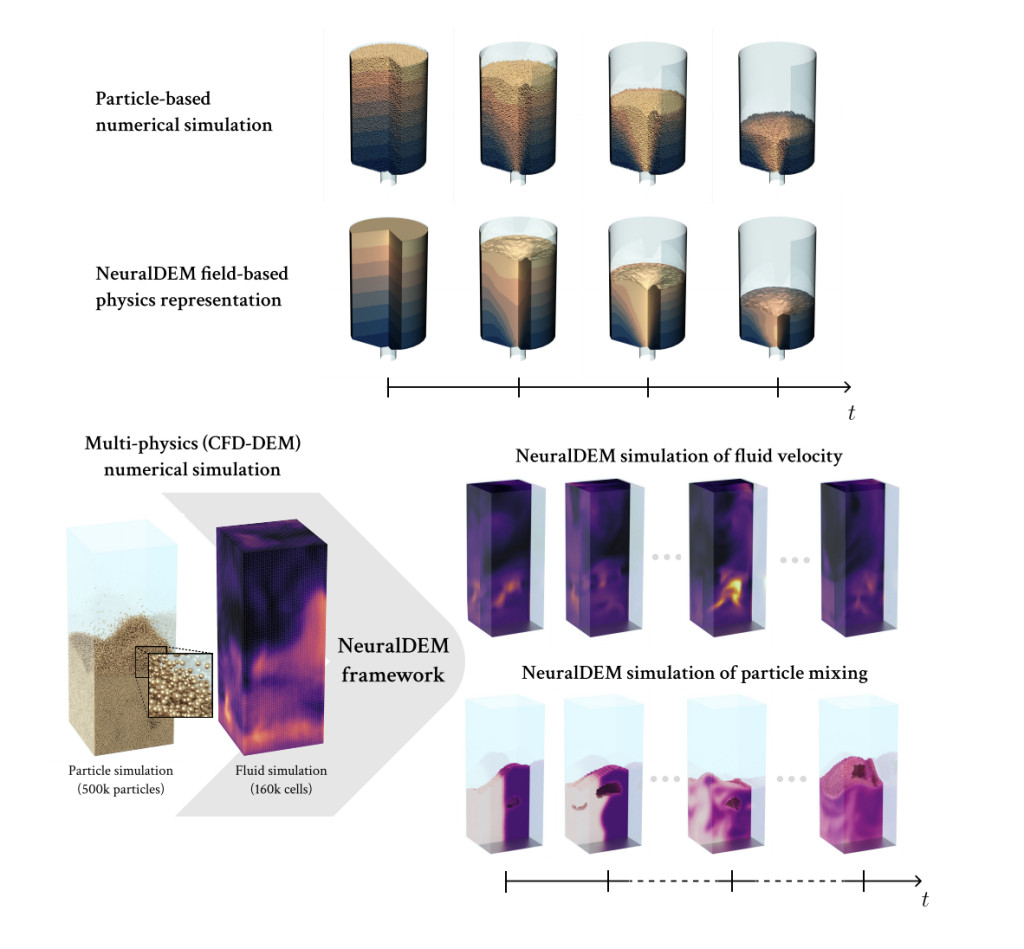

Developments in simulating particulate flows have significantly impacted industries ranging from mining to pharmaceuticals. Particulate systems consist of granular materials interacting with each other and surrounding fluids, and their accurate modeling is critical for optimizing processes. However, traditional numerical methods like the Discrete Element Method (DEM) face substantial computational limitations. These methods track particle movements and interactions by solving Newton’s equations of motion, which require enormous computational resources. Coupled with fluid dynamics simulations, DEM becomes even more demanding, making large-scale or long-duration simulations impractical for real-time applications.
One of the central challenges in this domain lies in the multiscale nature of particulate systems. Simulating millions of particles interacting over time necessitates microsecond-scale timesteps, causing simulations to run for hours or even days. Also, DEM requires extensive calibration of microscopic material properties, such as friction coefficients, to achieve accurate macroscopic results. Such calibration is tedious and error-prone, further complicating the integration of these simulations into iterative industrial workflows. Existing methods, although correct, need help to accommodate the vast computational demands of industrial systems with over 500,000 particles or fluid cells.
Researchers from NXAI GmbH, Institute for Machine Learning, JKU Linz, University of Amsterdam, and The Netherlands Cancer Institute developed NeuralDEM. NeuralDEM employs deep learning to replace the computationally intensive routines of DEM and CFD-DEM. This framework models particle dynamics and fluid interactions as continuous fields, significantly reducing computational complexity. By leveraging multi-branch neural operators, NeuralDEM directly predicts macroscopic behaviors such as flow regimes and transport phenomena without requiring detailed microscopic parameter calibration. This ability to generalize across diverse system conditions is a key innovation, enabling seamless simulation of varying geometries, particle properties, and flow conditions.
The architecture of NeuralDEM is built on the concept of multi-branch transformers. These neural operators process multiple physical phenomena simultaneously. For example, the framework uses primary branches to model core physics like particle displacement and fluid velocity, while auxiliary branches handle macroscopic quantities such as particle transport and mixing. This design allows NeuralDEM to simulate highly complex scenarios involving 500,000 particles and 160,000 fluid cells, as demonstrated in the fluidized bed reactor experiments. Unlike traditional DEM, NeuralDEM operates on coarser timesteps, achieving real-time simulation performance for long-duration processes.
In experimental validation, NeuralDEM was applied to hopper and fluidized bed reactor systems, showcasing its versatility and efficiency. In hopper simulations involving 250,000 particles, NeuralDEM accurately captured macroscopic flow phenomena such as mass flow and funnel flow regimes. It successfully predicted outflow rates, drainage times, and residual material volumes with minimal deviation from ground-truth DEM results. For instance, NeuralDEM estimated drainage times within 0.19 seconds of DEM calculations and predicted residual material volumes with an average error of 0.41%. These simulations required only a fraction of the computational time compared to DEM, achieving real-time performance.
In fluidized bed reactors, NeuralDEM demonstrated its capacity to model fast and transient phenomena involving strong particle-fluid interactions. Simulations with 500,000 particles and 160,000 fluid cells accurately replicated mixing behaviors, residence times, and dynamic flow patterns. The researchers highlighted NeuralDEM’s ability to simulate 28-second trajectories in just 2800 machine learning timesteps, a significant reduction compared to traditional methods. This efficiency positions NeuralDEM as a transformative tool for industrial applications requiring rapid and reliable process modeling.
The research presents key takeaways that highlight NeuralDEM’s potential as a game-changing technology:
- Scalability: Successfully simulated systems with up to 500,000 particles and 160,000 fluid cells, significantly extending the applicability of numerical modeling to industrial-scale problems.
- Accuracy: Achieved high fidelity in modeling complex flow regimes, with errors as low as 0.41% for residual material predictions.
- Efficiency: Reduced computational times from hours to real-time, making iterative design and optimization feasible.
- Generality: Demonstrated robustness across varying system parameters, including geometries, material properties, and flow velocities.
- Innovation: Introduced multi-branch neural operators capable of decoupling microscopic and macroscopic modeling for enhanced flexibility and precision.

In conclusion, NeuralDEM represents a leap forward in the simulation of particulate flows, bridging the gap between computational feasibility and industrial applicability. By leveraging deep learning to address the limitations of traditional methods, NeuralDEM has redefined the landscape of numerical modeling. Its efficiency, scalability, and accuracy make it a pivotal tool for industries aiming to optimize processes and accelerate engineering cycles. The results of this research showcase a clear pathway for integrating advanced simulations into real-world workflows, unlocking new possibilities for innovation in particulate system modeling.
Check out the Paper and Project. All credit for this research goes to the researchers of this project. Also, don’t forget to follow us on Twitter and join our Telegram Channel and LinkedIn Group. If you like our work, you will love our newsletter.. Don’t Forget to join our 55k+ ML SubReddit.
[FREE AI WEBINAR] Implementing Intelligent Document Processing with GenAI in Financial Services and Real Estate Transactions– From Framework to Production
The post NeuralDEM: Pioneering High-Performance Simulation of Large-Scale Particulate Systems with Multi-Branch Neural Operator Architectures appeared first on MarkTechPost.
Source: Read MoreÂ

